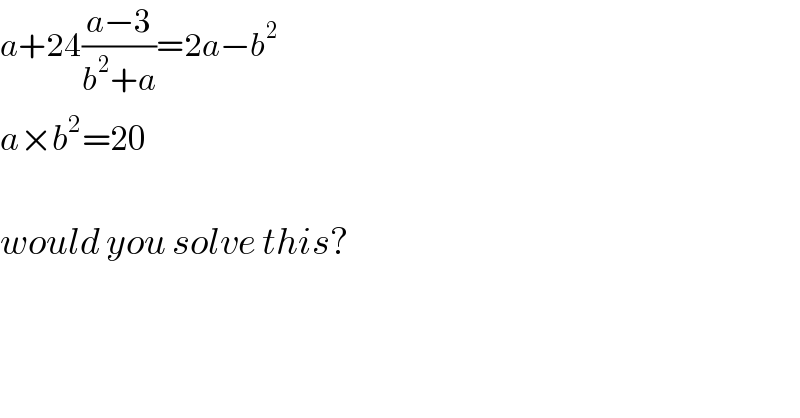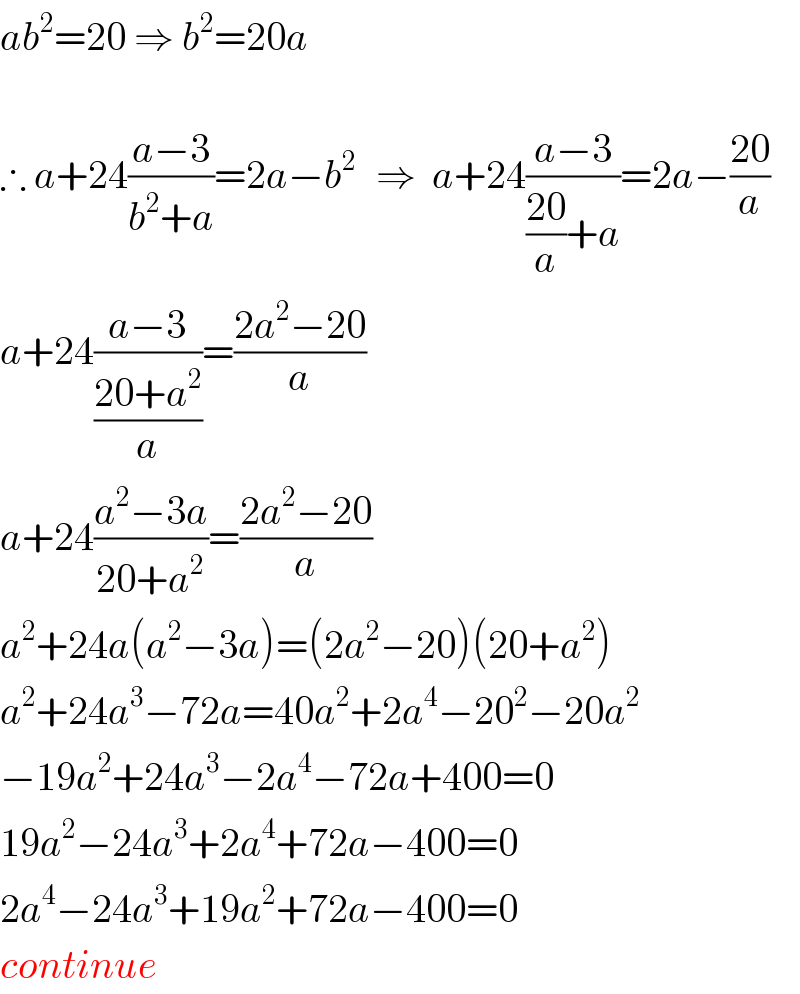Question Number 5159 by 1771727373 last updated on 24/Apr/16

$${a}+\mathrm{24}\frac{{a}−\mathrm{3}}{{b}^{\mathrm{2}} +{a}}=\mathrm{2}{a}−{b}^{\mathrm{2}\:} \\ $$$${a}×{b}^{\mathrm{2}} =\mathrm{20} \\ $$$$ \\ $$$${would}\:{you}\:{solve}\:{this}? \\ $$
Answered by FilupSmith last updated on 24/Apr/16

$${ab}^{\mathrm{2}} =\mathrm{20}\:\Rightarrow\:{b}^{\mathrm{2}} =\mathrm{20}{a} \\ $$$$ \\ $$$$\therefore\:{a}+\mathrm{24}\frac{{a}−\mathrm{3}}{{b}^{\mathrm{2}} +{a}}=\mathrm{2}{a}−{b}^{\mathrm{2}\:} \:\:\Rightarrow\:\:{a}+\mathrm{24}\frac{{a}−\mathrm{3}}{\frac{\mathrm{20}}{{a}}+{a}}=\mathrm{2}{a}−\frac{\mathrm{20}}{{a}} \\ $$$${a}+\mathrm{24}\frac{{a}−\mathrm{3}}{\frac{\mathrm{20}+{a}^{\mathrm{2}} }{{a}}}=\frac{\mathrm{2}{a}^{\mathrm{2}} −\mathrm{20}}{{a}} \\ $$$${a}+\mathrm{24}\frac{{a}^{\mathrm{2}} −\mathrm{3}{a}}{\mathrm{20}+{a}^{\mathrm{2}} }=\frac{\mathrm{2}{a}^{\mathrm{2}} −\mathrm{20}}{{a}} \\ $$$${a}^{\mathrm{2}} +\mathrm{24}{a}\left({a}^{\mathrm{2}} −\mathrm{3}{a}\right)=\left(\mathrm{2}{a}^{\mathrm{2}} −\mathrm{20}\right)\left(\mathrm{20}+{a}^{\mathrm{2}} \right) \\ $$$${a}^{\mathrm{2}} +\mathrm{24}{a}^{\mathrm{3}} −\mathrm{72}{a}=\mathrm{40}{a}^{\mathrm{2}} +\mathrm{2}{a}^{\mathrm{4}} −\mathrm{20}^{\mathrm{2}} −\mathrm{20}{a}^{\mathrm{2}} \\ $$$$−\mathrm{19}{a}^{\mathrm{2}} +\mathrm{24}{a}^{\mathrm{3}} −\mathrm{2}{a}^{\mathrm{4}} −\mathrm{72}{a}+\mathrm{400}=\mathrm{0} \\ $$$$\mathrm{19}{a}^{\mathrm{2}} −\mathrm{24}{a}^{\mathrm{3}} +\mathrm{2}{a}^{\mathrm{4}} +\mathrm{72}{a}−\mathrm{400}=\mathrm{0} \\ $$$$\mathrm{2}{a}^{\mathrm{4}} −\mathrm{24}{a}^{\mathrm{3}} +\mathrm{19}{a}^{\mathrm{2}} +\mathrm{72}{a}−\mathrm{400}=\mathrm{0} \\ $$$${continue} \\ $$
Answered by Yozzii last updated on 28/Apr/16
![a(b^2 +a)+24(a−3)=(2a−b^2 )(b^2 +a) ab^2 +a^2 +24a−72=2ab^2 +2a^2 −b^4 −ab^2 b^4 −a^2 +24a−72=0 b^4 =a^2 −24a+72 b^4 =((400)/a^2 ) ∴ 400=a^4 −24a^3 +72a^2 a^4 −24a^3 +72a^2 −400=0 (∗) Let f(x)=x^4 −24x^3 +72x^2 −400. By trial and error, and application of the intermediate value theorem, a root for the equation exists in the interval [20.5,20.6]. f^′ (x)=4x^3 −72x^2 +144x By the Newton−Raphson method the n+1 th approximation to the root of f(x)=0, given the n th approximation, is found by x_(n+1) =x_n −((f(x_n ))/(f^′ (x_n ))) x_(n+1) =((3x_n ^4 −48x_n ^3 +72x_n ^2 +400)/(4x_n ^3 −72x_n ^2 +144x_n )) Let x_1 =((20.5+20.6)/2)=20.55. ⇒x_2 ≈20.540974 ⇒x_3 ≈20.540961 ⇒x_4 ≈20.540961 ∴ a≈20.541. Note that (∗) has more than just one real root. This same method could be used to search for other real roots. Since b^2 =((20)/a), if b∈R⇒a>0 ∴ b=±(√((20)/(20.541)))≈±0.9867](https://www.tinkutara.com/question/Q5178.png)
$${a}\left({b}^{\mathrm{2}} +{a}\right)+\mathrm{24}\left({a}−\mathrm{3}\right)=\left(\mathrm{2}{a}−{b}^{\mathrm{2}} \right)\left({b}^{\mathrm{2}} +{a}\right) \\ $$$${ab}^{\mathrm{2}} +{a}^{\mathrm{2}} +\mathrm{24}{a}−\mathrm{72}=\mathrm{2}{ab}^{\mathrm{2}} +\mathrm{2}{a}^{\mathrm{2}} −{b}^{\mathrm{4}} −{ab}^{\mathrm{2}} \\ $$$${b}^{\mathrm{4}} −{a}^{\mathrm{2}} +\mathrm{24}{a}−\mathrm{72}=\mathrm{0} \\ $$$${b}^{\mathrm{4}} ={a}^{\mathrm{2}} −\mathrm{24}{a}+\mathrm{72} \\ $$$${b}^{\mathrm{4}} =\frac{\mathrm{400}}{{a}^{\mathrm{2}} } \\ $$$$\therefore\:\mathrm{400}={a}^{\mathrm{4}} −\mathrm{24}{a}^{\mathrm{3}} +\mathrm{72}{a}^{\mathrm{2}} \\ $$$${a}^{\mathrm{4}} −\mathrm{24}{a}^{\mathrm{3}} +\mathrm{72}{a}^{\mathrm{2}} −\mathrm{400}=\mathrm{0}\:\:\:\:\:\:\:\:\:\:\left(\ast\right) \\ $$$$ \\ $$$${Let}\:{f}\left({x}\right)={x}^{\mathrm{4}} −\mathrm{24}{x}^{\mathrm{3}} +\mathrm{72}{x}^{\mathrm{2}} −\mathrm{400}. \\ $$$${By}\:{trial}\:{and}\:{error},\:{and}\:{application} \\ $$$${of}\:{the}\:{intermediate}\:{value}\:{theorem},\: \\ $$$${a}\:{root}\:{for}\:{the}\:{equation}\:{exists}\:{in} \\ $$$${the}\:{interval}\:\left[\mathrm{20}.\mathrm{5},\mathrm{20}.\mathrm{6}\right]. \\ $$$${f}^{'} \left({x}\right)=\mathrm{4}{x}^{\mathrm{3}} −\mathrm{72}{x}^{\mathrm{2}} +\mathrm{144}{x} \\ $$$${By}\:{the}\:{Newton}−{Raphson}\:{method} \\ $$$${the}\:{n}+\mathrm{1}\:{th}\:{approximation}\:{to}\:{the} \\ $$$${root}\:{of}\:{f}\left({x}\right)=\mathrm{0},\:{given}\:{the}\:{n}\:{th}\:{approximation}, \\ $$$${is}\:{found}\:{by} \\ $$$${x}_{{n}+\mathrm{1}} ={x}_{{n}} −\frac{{f}\left({x}_{{n}} \right)}{{f}^{'} \left({x}_{{n}} \right)} \\ $$$${x}_{{n}+\mathrm{1}} =\frac{\mathrm{3}{x}_{{n}} ^{\mathrm{4}} −\mathrm{48}{x}_{{n}} ^{\mathrm{3}} +\mathrm{72}{x}_{{n}} ^{\mathrm{2}} +\mathrm{400}}{\mathrm{4}{x}_{{n}} ^{\mathrm{3}} −\mathrm{72}{x}_{{n}} ^{\mathrm{2}} +\mathrm{144}{x}_{{n}} } \\ $$$${Let}\:{x}_{\mathrm{1}} =\frac{\mathrm{20}.\mathrm{5}+\mathrm{20}.\mathrm{6}}{\mathrm{2}}=\mathrm{20}.\mathrm{55}. \\ $$$$\Rightarrow{x}_{\mathrm{2}} \approx\mathrm{20}.\mathrm{540974} \\ $$$$\Rightarrow{x}_{\mathrm{3}} \approx\mathrm{20}.\mathrm{540961} \\ $$$$\Rightarrow{x}_{\mathrm{4}} \approx\mathrm{20}.\mathrm{540961} \\ $$$$\therefore\:{a}\approx\mathrm{20}.\mathrm{541}.\:{Note}\:{that}\:\left(\ast\right)\:{has}\:{more} \\ $$$${than}\:{just}\:{one}\:{real}\:{root}.\:{This}\:{same} \\ $$$${method}\:{could}\:{be}\:{used}\:{to}\:{search}\:{for} \\ $$$${other}\:{real}\:{roots}.\:{Since}\:{b}^{\mathrm{2}} =\frac{\mathrm{20}}{{a}},\:{if} \\ $$$${b}\in\mathbb{R}\Rightarrow{a}>\mathrm{0}\:\therefore\:{b}=\pm\sqrt{\frac{\mathrm{20}}{\mathrm{20}.\mathrm{541}}}\approx\pm\mathrm{0}.\mathrm{9867} \\ $$
